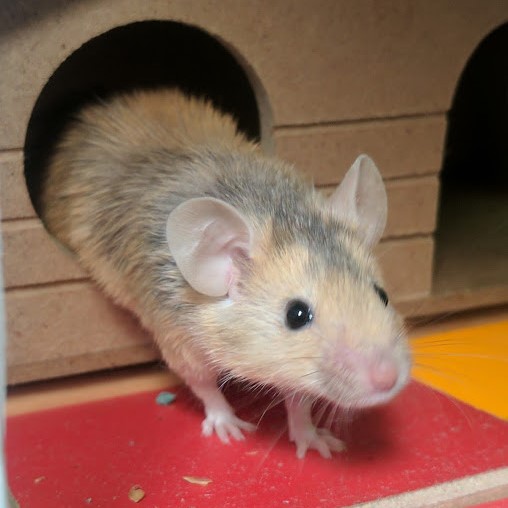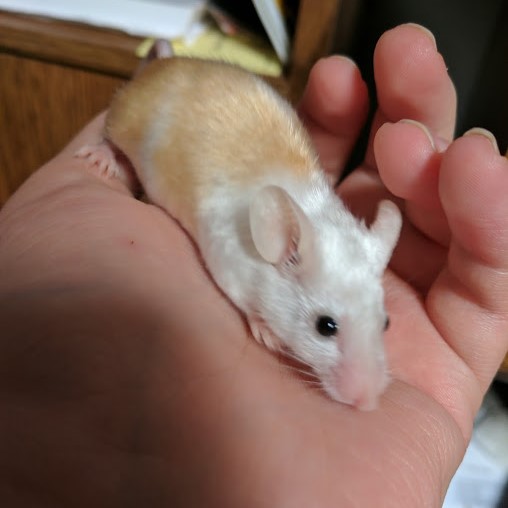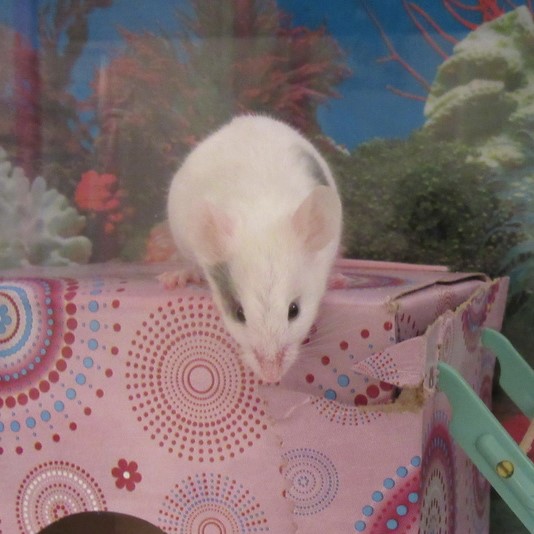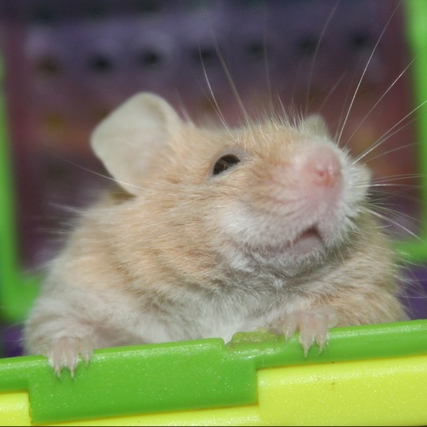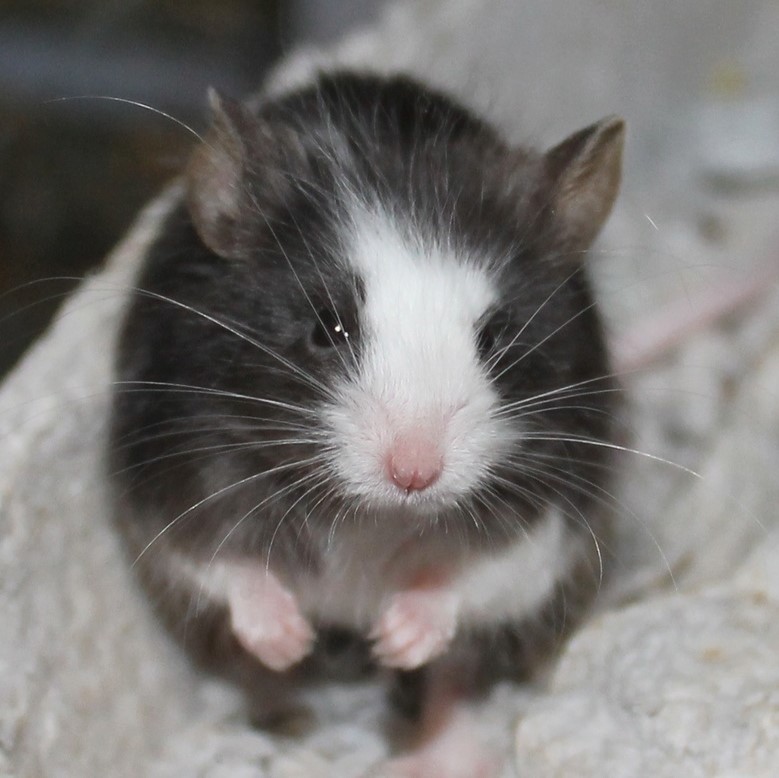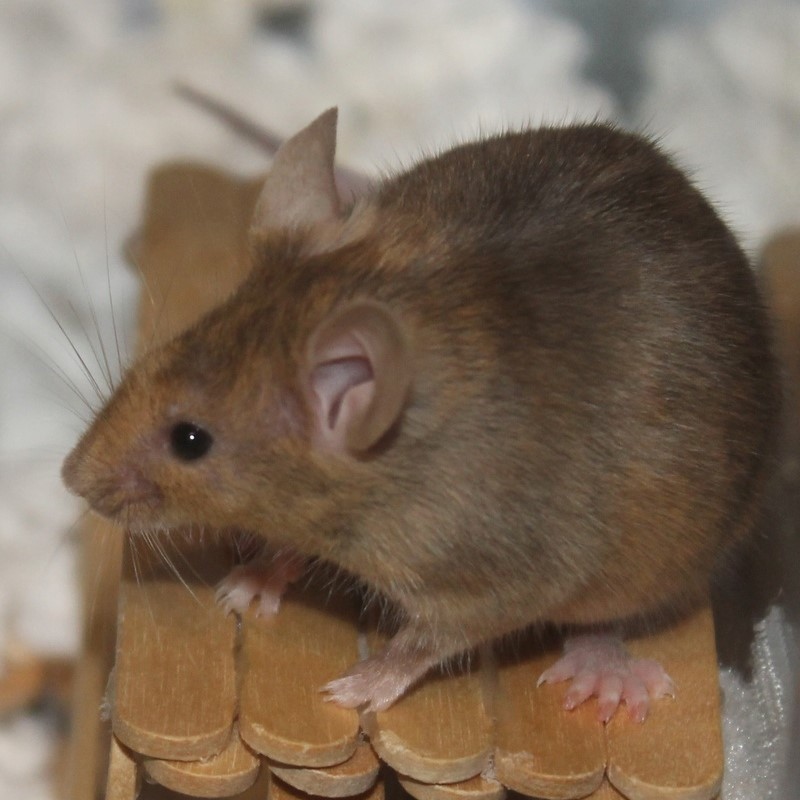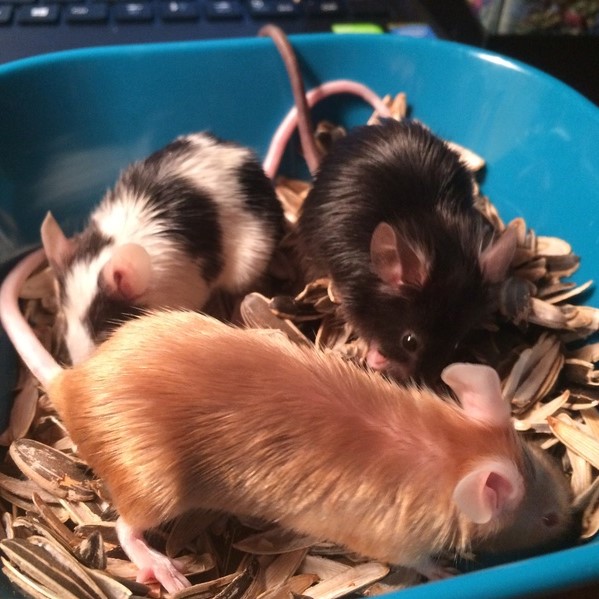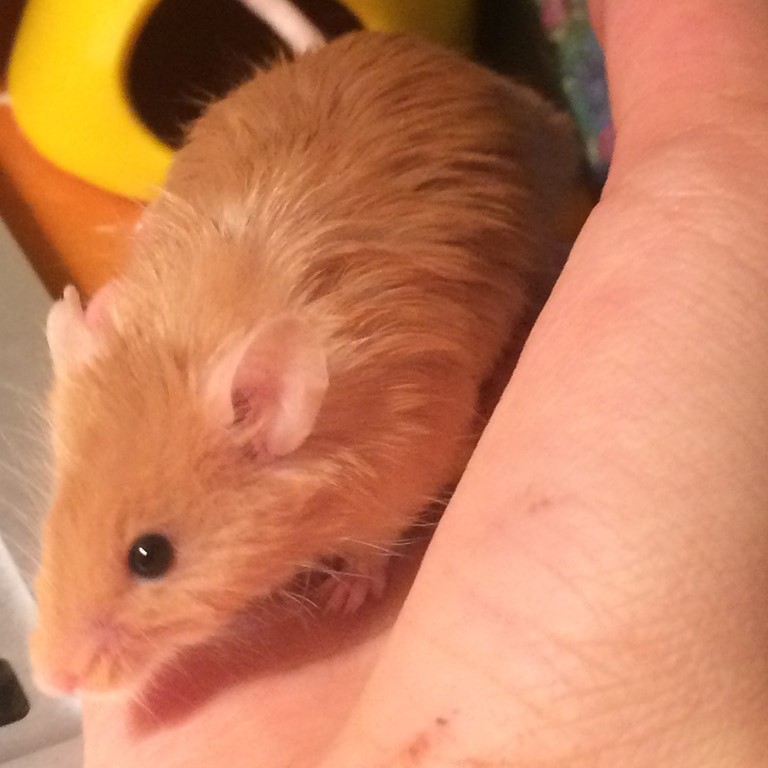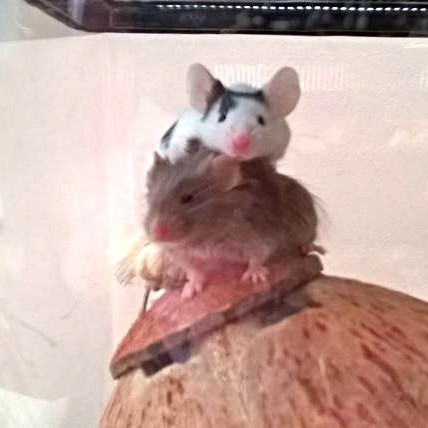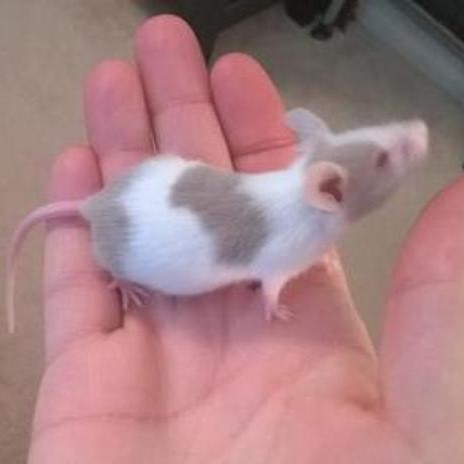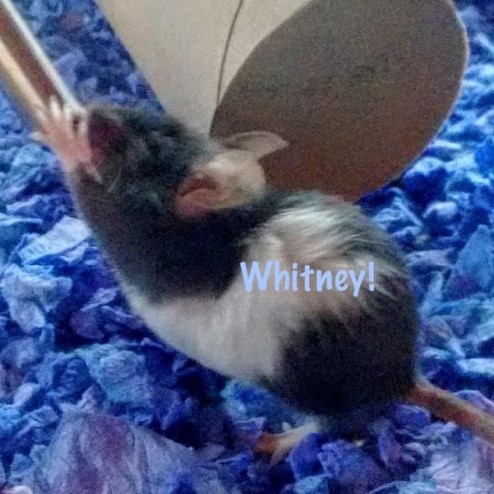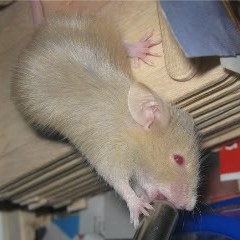Itching, Hair Loss, and Parasites
3 posters
Page 1 of 1
 Itching, Hair Loss, and Parasites
Itching, Hair Loss, and Parasites
Barbering
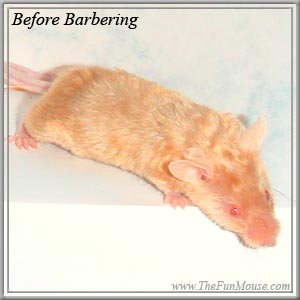
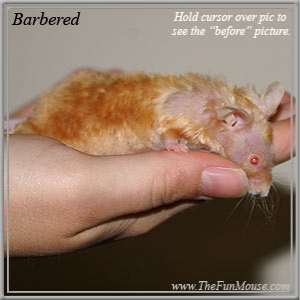
Over-grooming, also called "barbering," is a possible cause of bald spots. Some mice over-groom themselves and some over groom their companions. Some mice will even pluck the whiskers of their companions. If you have a barbering mouse, try giving them something else to do with their time. Give them a new toy or a jungle gym. If you give them a new hobby they might forget about over-grooming. For fun toy ideas, check out the following links:
Housing Pictures -- https://www.petmousefanciers.com/t230-housing-pictures
Popsicle stick toys -- https://www.petmousefanciers.com/t47-popsicle-stick-mes
Totally Free Toy Ideas -- https://www.petmousefanciers.com/t46-totally-free-toy-ideas
Check out the Mouse DIYs section for more ideas and tutorials -- https://www.petmousefanciers.com/f21-mouse-diys
If you have a cage with bars and your mouse has a bald spot on his nose or forehead, then the problem might be from him sticking his nose out of the bars and rubbing it raw. If your mouse isn't in a cage and it has the bald spot on its nose, try checking the house he is in for places where he might be sticking his nose where it doesn't belong. If the nose gets rubbed too much, it can cause an open wound and risk infection. Try eliminating the problem before it gets that bad.
Chronic Scratching

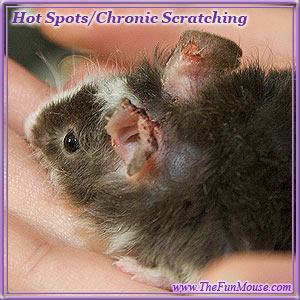

Scratching becomes a problem when it so excessive that it leads to hair loss, redness of the skin, or open wounds. If your mouse has one of these problems you need to act quickly to resolve the situation. The longer the problem goes unresolved the more chances it will develop into chronic scratching. Chronic scratching is similar to OCD (Obsessive Compulsive Disorder) in humans. If chronic scratching gets out of control it can cause many problems including infection, which can result in death. If your mouse has open wounds or an infection, it is best to see a vet. A vet may prescribe an antihistamine for the scratching as well as an antibiotic to help fight the infection, such as Baytril. In the time before you can get your mouse to a vet you can apply Neosporin PLUS or Cortaid as often as the tube recommends. Make sure you rub it in extremely well so the mouse doesn't ingest it.
A mouse may start to scratch for many different reasons, however, the scratching can cause even more skin irritation than the initial problem. The irritation caused by the scratching causes more itchiness, causing your mouse to scratch more, causing more irritation, causing more scratching. This is a never-ending cycle that is hard to break as it quickly becomes a habit, sometimes even if the initial problem is gone. Once this habit has taken effect it is very hard to break. It is your job to give your mouse another habit to take his or her mind off the itching. Try giving your mouse lots of distractions. Things that often work best are those that the mouse can climb, chew, and shred.
Unfortunately, chronic scratchers often relapse, even if the mouse is never exposed to the initial problem again. This may be a battle for the entire life of your mouse. The faster you can find the initial problem to prevent chronic scratching or the faster you can break a relapse, the better chances that our mouse will not relapse as often.
Food Allergies
The most common food allergies for mice are peanuts, sunflower seeds, and wheat. However, a mouse can be allergic to anything. Additionally, most mice should be given a low protein diet of 13% or less. The type of protein also makes a difference. There are many different kinds of protein, obtained from different food sources. Meat protein is the best kind of protein for a mouse. If you need to cut your mouse back on a soy-based protein (which is most commonly found in food mixes), it is best to give them cooked meat supplements.Food allergies usually manifest as what are known as "hot spots." Hot spots are areas on your mouse that are very itchy. The mouse scratches these places bald and they often bleed. Hot spots usually start on the back of the ears and neck between their head and back, sometimes continuing down their back. If your mouse has hot spots remove all of the common problem foods such as peanuts, sunflower seeds, wheat, and also lower the soy protein in the diet. If one of these things is the problem, your mouse will show signs of improvement within a week as long as you caught the problem in time (before chronic scratching sets in). This is the best way to deal with an allergy that isn't out of control. Usually simply taking these steps will solve the problem.
If the hot spots are already severe or removing the common problematic foods doesn't work, place our mouse on an all rice diet. Mice are very rarely allergic to rice, which is one of the main reasons it's used for this. You can also add supplements such as vitamins to the water to help get more nutrition in them. A mouse should show improvements after a week on a rice diet. When your mouse has made significant improvements you may start adding different foods to their diet. Only add one new thing a week so you can observe the mouse. If the skin flares up again, remove the last food you added and take note that your mouse is likely allergic to that food. Wait until the skin is looking better and start over again by adding one new food a week (minus the problematic foods). This will help you determine what your mouse is allergic to. If you give your mouse more than one new thing a week, you will not be able to determine what your mouse is allergic to.
Note that on average brindle Avy, lethal yellow (red) Ay, and runts have more problems with food allergies than other mice. These mice are at a much higher risk for developing health-related problems, especially food allergies.
Bedding Allergies
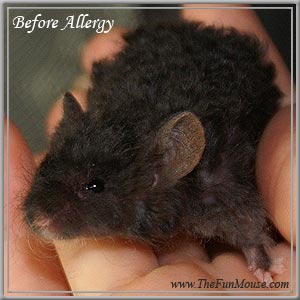

Bedding allergies can cause hair loss in any location (most often the underside), inflammation of the skin, puffy eyes, sneezing, wheezing, difficulty breathing, and even bleeding from the ears, eyes, and nose. A mouse doesn't need to have more than one of these symptoms to signify a bedding allergy. If you suspect that your mouse is allergic to the bedding, the best thing you can do is place them on a dust-free paper-based bedding, plain shredded paper, or fleece right away. If the problem is in fact the bedding, the symptoms should improve within a week or 2. If your mouse has developed asthma from wood bedding or scented bedding ("naturally" scented or otherwise), these symptoms will likely never completely go away. If you find that your mouse is allergic to wood bedding, never use any kind of wood bedding for them again. A mouse that is allergic to one kind of wood is extremely likely to be allergic to other kinds of wood as well. Mice should never be on scented bedding such as mint, lilac, rose, etc. These scented beddings are not safe.
Mites
Mites are little parasites that can hide in a mouse's fur. Some species of mites can be seen (but barely) while others can't be seen at all by the naked eye. Signs that your mice have them are little black dots (the mites), tiny round specks (the nits- eggs), flaky skin (mange), or intense scratching. A vet can verify if your mouse has mites or not by taking a sample from the mouse (painless) and looking through a microscope for mites and nits. If your mouse has mites you need to treat them right away. The treatment for mites is the same as the treatment for lice, seen under the "Ivermectin Treatment" heading below. If gone untreated it can be very harmful to your mouse's health. They can even kill your mouse if left untreated long enough. Mites are host specific, not species-specific. This means that they will jump onto and they can live off other animals but they prefer their species of host (in this case it is mice).Lice
Lice are parasites that will cause the same problems and can be prevented in the same ways as mites. Mites and lice look different in their adult stage but they look very similar in the middle of their life span. Lice look like little brown/black dots in the middle of their life span. As they grow into full adults they look red with a long body while mites are round and smaller (much like juvenile lice). Mites tend not to move, or not move much. Lice are very quick little things. When inspecting and finding lice, they will move extremely quickly, making one think they may just be seeing things that are not really there. Lice are species-specific. They will not transfer to humans (human lice are much different), cats, dogs, etc. They may hop on for a ride but will not stay for any length of time. They can not live off of species other than their specific host. I have seen it stated on many sites that lice will not jump out of tanks into other tanks, climb walls, climb shelves, etc. I have found this to be far from the truth.Below are some pictures of what lice look like magnified. I'm sorry the pics are not terribly clear but they will give you an idea of what to look for.
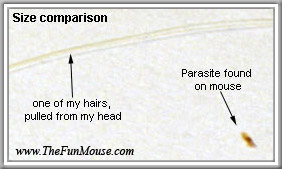
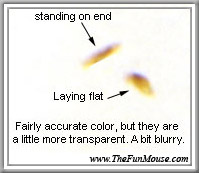




Transmission of Parasites and Reducing the Risk
There are several ways your mouse can get parasites. One way is critter bedding. It is not unheard of for bedding to have parasites. The leading parasite carrying beddings are Timothy hay and Carefresh. However, almost all beddings can carry parasites. If your mouse gets parasites this way you need to contact the company that makes the bedding so they know there is a problem. If you worry about this happening you can always freeze or bake the bedding before using it in your mouse's cage. You can freeze bedding at 0°F (-17°C) for 24 to 48 hours or you can bake it at 140°F (60°C) for 30 minutes in an oven with a shallow pan. Do note that you will need to bake bedding longer if you are baking larger quantities! The bedding needs to be heated all the way through for 30 minutes. It may take a while to get the core bedding temperature to the 140°F needed. Note that paper and wood will only combust without a naked flame in temperatures at or above 451°F (233°C). However, if it is exposed to a naked flame, it can catch fire extremely easily. Baking should always be well supervised. Be sure that any baked or frozen bedding is room temperature again before putting your mouse on it! If you don't then it could kill your little one! If you store your bedding where wild animals can come in contact with it, then parasites can be transferred that way also. If you have any wild mice in your house they can transfer parasites to your mice. Many homes have wild mice and many times people don't even know it. The best thing you can do is try and avoid parasites as best as you can. But once your mouse has them it must be treated as the alternative is worse.More information about quarantine to prevent bugs and illnesses can be found at this link: https://www.petmousefanciers.com/t7-quarantine
Ivermectin Treatment
**Please know that it is always recommended to consult a vet for health concerns or if you have any questions regarding this treatment. Our opinions do NOT override the opinions of vets. If this is not mixed right it may not get rid of the parasites or it could harm your mice.**Mites are very common in mice, especially pet store mice. Untreated parasites can have catastrophic health consequences and can even result in death. Mice will scratch at themselves, pull their hair out, and chew at their bodies until they bleed and become infected because of the severe itching. Once it goes this far, even after the treatment has been completed and the parasites are gone, the mouse often has developed a scratching habit and is unable to stop mutilating itself. It is a terrible thing to have to witness. For these reasons, many of us treat all mice that come into our homes with ivermectin, regardless of whether or not they are symptomatic, just to be safe.
Ivermectin is a safe, effective, and inexpensive over-the-counter medication that treats lice and mites in mice. Some vets will try to prescribe oral ivermectin, but it is risky because there is no way to properly dose it for a mouse. Do not allow your mice to be treated with oral paste! The topical ivermectin is completely safe and more effective than oral ivermectin. The correct product is a Cattle Pour-On with a concentration of 5mg ivermectin per mL. You can purchase it at a farm supply/tractor store or online, often for under $20. This picture shows the correct product.
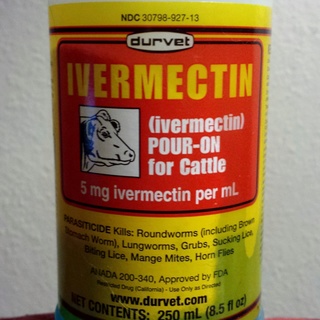
For UK owners: Xeno 50 Mini
stephlisa wrote:This is the ivermectin I've used (sourced from the UK):
Http://www.petdrugsonline.co.uk/small-pets/fleas-lice-and-mites/spot-on-treatments/xeno-50-mini
MouseLover wrote:I use the same one as stephlisa - you're supposed to weigh the animal and add a certain number of drops depending on their weight, so it won't be too strong for little mice. The average mouse will need 2 or 3 drops.
It is very important to follow these directions when diluting the ivermectin. The correct dosage is 1 part ivermectin to 5 parts water. For example: Measure one teaspoon of ivermectin (5 ml) and then add 5 teaspoons of water (25 ml). The ivermectin will begin separating quickly, so you must shake well and shake often! The mixed ivermectin is stable at room temperature for 6 months, just be sure to shake very well before using again.
To treat the mouse, simply place one drop of the diluted ivermectin in between the shoulder blades, then use your fingertip to smear it down their back. You should use a syringe to do this to make sure you are giving the correct dose. One drop is approximately 0.01 ml (0.01). If you get too much on the mouse, try to wipe off the excess. Try to keep the mouse occupied for about 10 minutes to prevent the mouse from trying to lick off the medication, so that the medication has a chance to soak into the skin. Treat the mouse once every 7 days for 3 weeks, cleaning the cage as described below before each treatment. After completing the 3-week course of ivermectin, discontinue the treatment for 2 weeks. After those 2 weeks have passed, repeat the treatment protocol once every 7 days for another 3 weeks.
In addition to treating the mouse, it's important to treat their environment. Thoroughly clean their tank and throw away any disposable items like toilet paper rolls, egg cartons, or cardboard. Plastic and ceramic items should be washed well. Wood items can be treated by using your diluted ivermectin to spray them. You should also lightly spray the fresh bedding and the mesh lid. This prevents any bugs from escaping, you want them trapped in there with the medicine. Make sure to let these items dry completely before putting your mouse back into the tank. There is no need to bleach the tanks or throw away all the toys. Lice and mites are host-specific, so you don’t have to worry about catching them.
This treatment has been used in female colonies that love to groom each other. No ill side effects were seen from them ingesting the spray on the backs of other mice. In addition, labs use this on pinkies with no ill side effects. It is safe for all ages of mice.
| The content on this page was first published on The Fun Mouse website and has been reposted with permission. Please do not reproduce in any way. |
Last edited by admin on Sat 23 Jan 2021, 2:19 pm; edited 4 times in total (Reason for editing : Information/Pictures updated)

AppleCheeks- Sr Member

- Join date : 2016-04-03
Posts : 123
 Not sure what is causing this skin issue
Not sure what is causing this skin issue
Hello!
I have a mouse that has a pretty big bald spot on his face that looks very raw. I can see it irritates him a lot, but I'm not sure how to treat it. I believe he has had mites before from being outside and I treated that by cleaning his cage and washing the effected areas and it help and it went away. He was perfectly fine for a couple of months and now this new issue appeared. It looks different from when he had mites so I'm not sure what to do for treatment. To me it looks like a burn spot because it's so raw. I've included pictures of what it looks like and also his cage set up because I was reading about how they can be bored and that causes them to over groom. Any advice????? I also have another mouse and he hasn't had any skin issues at all.
What it looks like:
https://i.servimg.com/u/f21/20/01/95/82/img_0810.jpg
https://i.servimg.com/u/f21/20/01/95/82/img_9710.jpg
https://i.servimg.com/u/f21/20/01/95/82/img_0710.jpg
Cage Setup:
https://i.servimg.com/u/f21/20/01/95/82/img_3710.jpg
I have a mouse that has a pretty big bald spot on his face that looks very raw. I can see it irritates him a lot, but I'm not sure how to treat it. I believe he has had mites before from being outside and I treated that by cleaning his cage and washing the effected areas and it help and it went away. He was perfectly fine for a couple of months and now this new issue appeared. It looks different from when he had mites so I'm not sure what to do for treatment. To me it looks like a burn spot because it's so raw. I've included pictures of what it looks like and also his cage set up because I was reading about how they can be bored and that causes them to over groom. Any advice????? I also have another mouse and he hasn't had any skin issues at all.
What it looks like:
https://i.servimg.com/u/f21/20/01/95/82/img_0810.jpg
https://i.servimg.com/u/f21/20/01/95/82/img_9710.jpg
https://i.servimg.com/u/f21/20/01/95/82/img_0710.jpg
Cage Setup:
https://i.servimg.com/u/f21/20/01/95/82/img_3710.jpg
Smee/Berlioz- New Member

- Join date : 2019-01-11
Posts : 3
 Re: Itching, Hair Loss, and Parasites
Re: Itching, Hair Loss, and Parasites
I have a female mouse who lived with two other female mice and during this time she was scratching and digging at the backs and bottoms of her hind legs. Since then, both of her cage mates have died but i have two new female mice to introduce to her and though her scratching hasnt worsened since her cage mates death, i would like for her to be happy and healthy so that i can introduce her to her new friends. Any recommendations?
Perla2003- New Member

- Join date : 2020-08-17
Posts : 2
 Re: Itching, Hair Loss, and Parasites
Re: Itching, Hair Loss, and Parasites
Her first cage mate didnt have any skin issues.
Perla2003- New Member

- Join date : 2020-08-17
Posts : 2
 Similar topics
Similar topics» Hair Loss
» Fur loss, constant itching.
» Hair Loss and Unresponsiveness
» Eye infection/hair loss help
» Loss of hair and scabbing
» Fur loss, constant itching.
» Hair Loss and Unresponsiveness
» Eye infection/hair loss help
» Loss of hair and scabbing
Page 1 of 1
Permissions in this forum:
You cannot reply to topics in this forum










